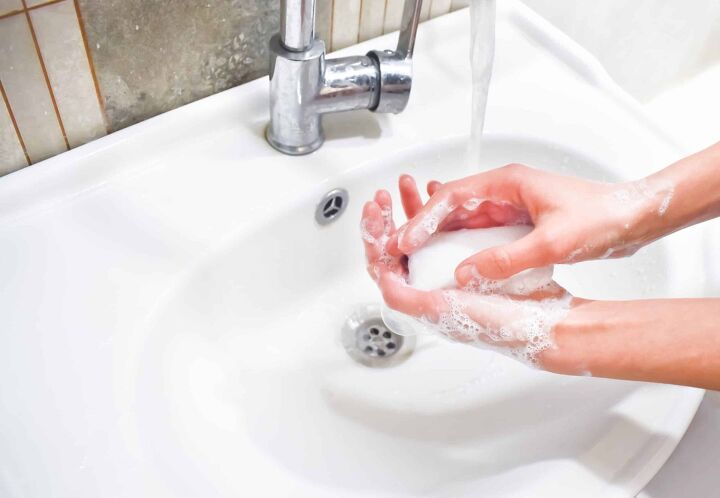How To Remove Expanding Foam Filler From Your Skin

Spray foam is a common, easy to install insulation to improve the efficiency of your home. The bad thing is that, unless you are covered head to toe, it is all too easy to get that spray foam on your skin. It can take hold quickly and can be very annoying to deal with even if it really doesn’t do any harm.
If you get expanding foam filler on your skin, wipe it off immediately while it’s still wet to remove as much of it as possible. Then, use acetone to remove any of the residual foam and wash your hands. If the foam is dry, use a pumice stone to break up the foam.
Follow this step-by-step guide and you should be able to get that annoying insulating spray off in no time. Whenever you use any household chemicals, it is a good idea to wash them off sooner rather than later anyway.
Step 1: Wipe When Wet
The first step to removing expanding foam filler insulation from your skin is to do so while the foam is still wet. Most of the time, you can wipe it off using a disposable wipe or a wet paper towel to get most of the insulation off. Just make sure to throw away whatever you use.
Even if you don’t get all of the foam filler off of your skin, it’s a good idea to do this anyway. It will make the later steps that much easier. Not only that, it is more difficult to get the foam filler off of your hands after it has dried, so wiping immediately is a good way to cut down the cleanup time.
Step 2: Using Acetone
After you have wiped away the wet foam from your hands, you can then work to get the rest off using acetone. If you have straight acetone available, this will work best. The most common type of household acetone is in the form of nail polish remover.
Before you start using it, check to make sure that the nail polish remover that you have has acetone in it. Not every nail polish remover will have that acetone and it won’t do much to clean the foam filler off of your hands without it.
Step 3: Wash Your Hands
Now that you have taken the necessary steps to remove the wet foam filler from your hands, it’s time to give your hands a good wash. This will help to get rid of the acetone and any remaining bits of the foam filler insulation.
It’s also a good idea to moisturize after you wash and dry your hands. This is because acetone will dry your hands out pretty thoroughly. Using lanolin or hand lotion will help to replace the oils that the acetone stripped away.
Step 4: If the Foam Has Dried
Dealing with foam filler insulation is much easier when it is wet. But we don’t always have the wherewithal or come to the realization that there is foam filler insulation on our hands. This can lead the foam filler insulation to dry and become that much harder to get off.
Should the foam filler insulation dry before you get a chance to remove it, don’t worry. Use a pumice stone to break apart and wear away as much of that dried foam as you can. It may take a few tries, but this should get the bulk of the spray foam insulation off. When you’re happy with the results, wash your hands with soap and water.
Step 5: Covering the Area
Because pumice stones are quite rough, it can really make your skin feel rough to the touch. The best way to combat this is to introduce some moisture to the area. For that, we will need either petroleum jelly or lanolin.
Apply it pretty liberally to the impacted area and cover it using some kind of plastic cling film, though a plastic glove will work better than anything else. Let it sit for a couple of hours so that it can work to repair the damage done to the skin and replenish the moisture levels.
Step 6: Rinse (and Repeat if Needed)
After the two hours have elapsed, take the covering off and wash your hands thoroughly with soap and water. Examine the impacted area and then reapply and recover as needed. It all depends on how much of the foam filler was on your hands to begin with and how aggressive you had to be with the pumice stone.
Remove Spray Foam From Your Hands Without Chemicals
Will Mineral Spirits Remove Spray Foam?
The short answer is yes, though there is a major “but” involved. Mineral spirits can be used to remove that foam filler insulation but only when it is still pliable or wet. If the foam has dried, you will have to use the aforementioned method to get it off.
Most of the time, people tend to make this mistake once before they start wearing gloves on a regular basis. That is the easiest, best, and most consistent way to keep spray foam insulation from getting all over your hands.
Check out this guide: How To Dispose Of Mineral Spirits
Will WD-40 Remove Expanding Foam?
WD-40 has been shown to do quite a lot of things. If you don’t have acetone on hand, you can also use WD-40 to get off expanding foam off while it is still wet and pliable. The WD-40 will break down the spray foam and make it easier to wash off.
The difficult thing about expanding foam is that when it cures or dries on your hands, the only way to get it off is by sanding it or scraping it. So, keep that in mind the next time that you use expanding foam because getting it on your hands could create a real pain of a cleanup effort.
How Do You Remove Expanding Foam from Glass?
Depending on the areas that you are applying the expanding foam insulation, there is a chance that you could get it on some glass surfaces. This is okay; it shouldn’t do any damage to the glass in the short-term. Still, you will want to remove it because it can create an unsightly stain that takes away from the visual appeal of the glass.
Just like cleaning your hands, there are a variety of methods that you can use to get it off when it is wet or pliable. If it has dried, however, you will need to use something like a razor blade – something thin and sharp – to remove the bulk of the filler foam and then clean the residue using a fairly strong cleaner. Make sure that when you are finished, you spray down the area with a light glass cleaner to finish the job.
How Long Does Expanding Foam Take to Cure?
For those who have used expanding foam insulation before, you know it doesn’t take very long to begin to cure, especially on the skin. Foam will generally be tack free within the first 20 or so minutes after application, so if you want to make cleaning your hands easy, take care of it within that time frame.
Expanding foam insulation can generally be plastered, sanded, cut, or painted a full 12 hours after it has been applied and should be 100% cured within 12-24 hours of application. If you need to clean any excess off of other surfaces, it should happen within the first 20 minutes of application for the easiest and quickest cleanup results. Otherwise, you will need something sharp to scrape off the excess.
Related Guides

Ryan Womeldorf has more than a decade of experience writing. He loves to blog about construction, plumbing, and other home topics. Ryan also loves hockey and a lifelong Buffalo sports fan.
More by Ryan Womeldorf



























